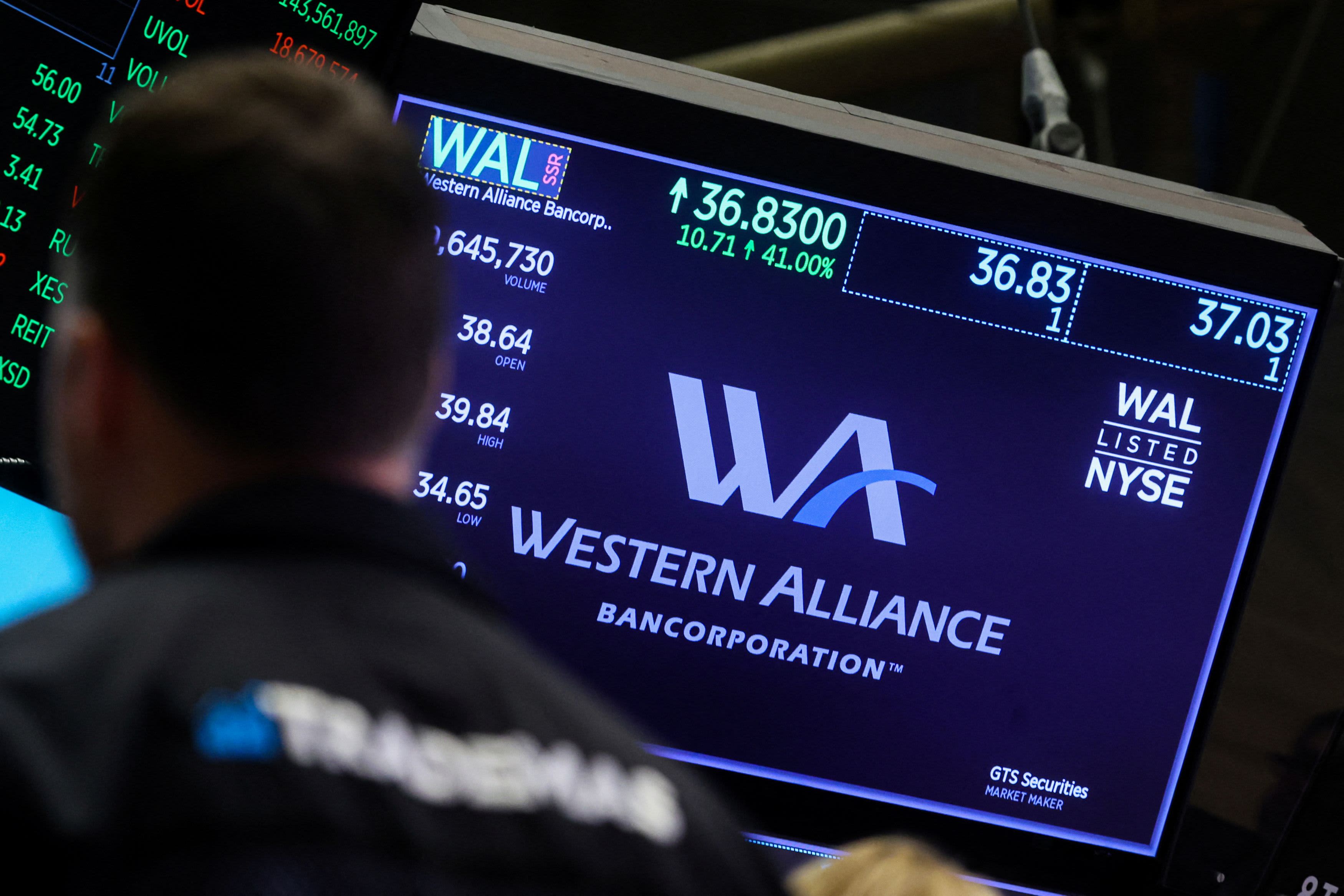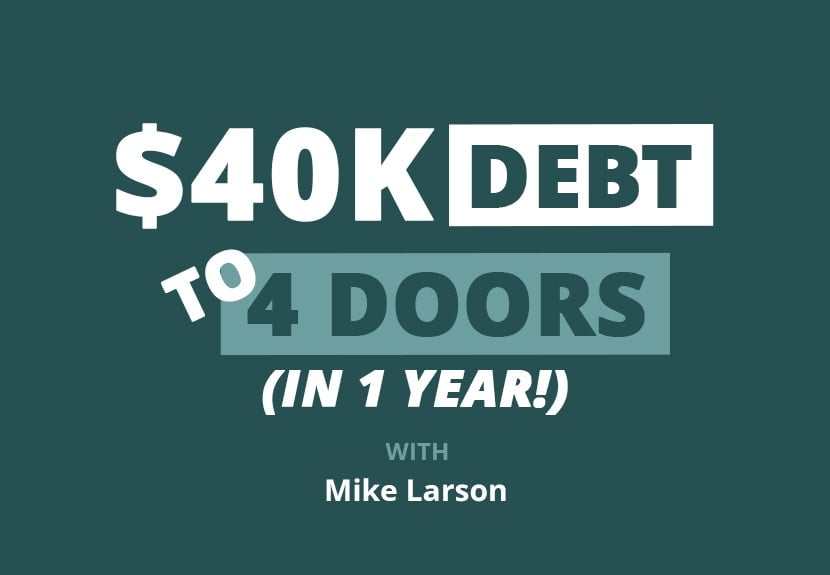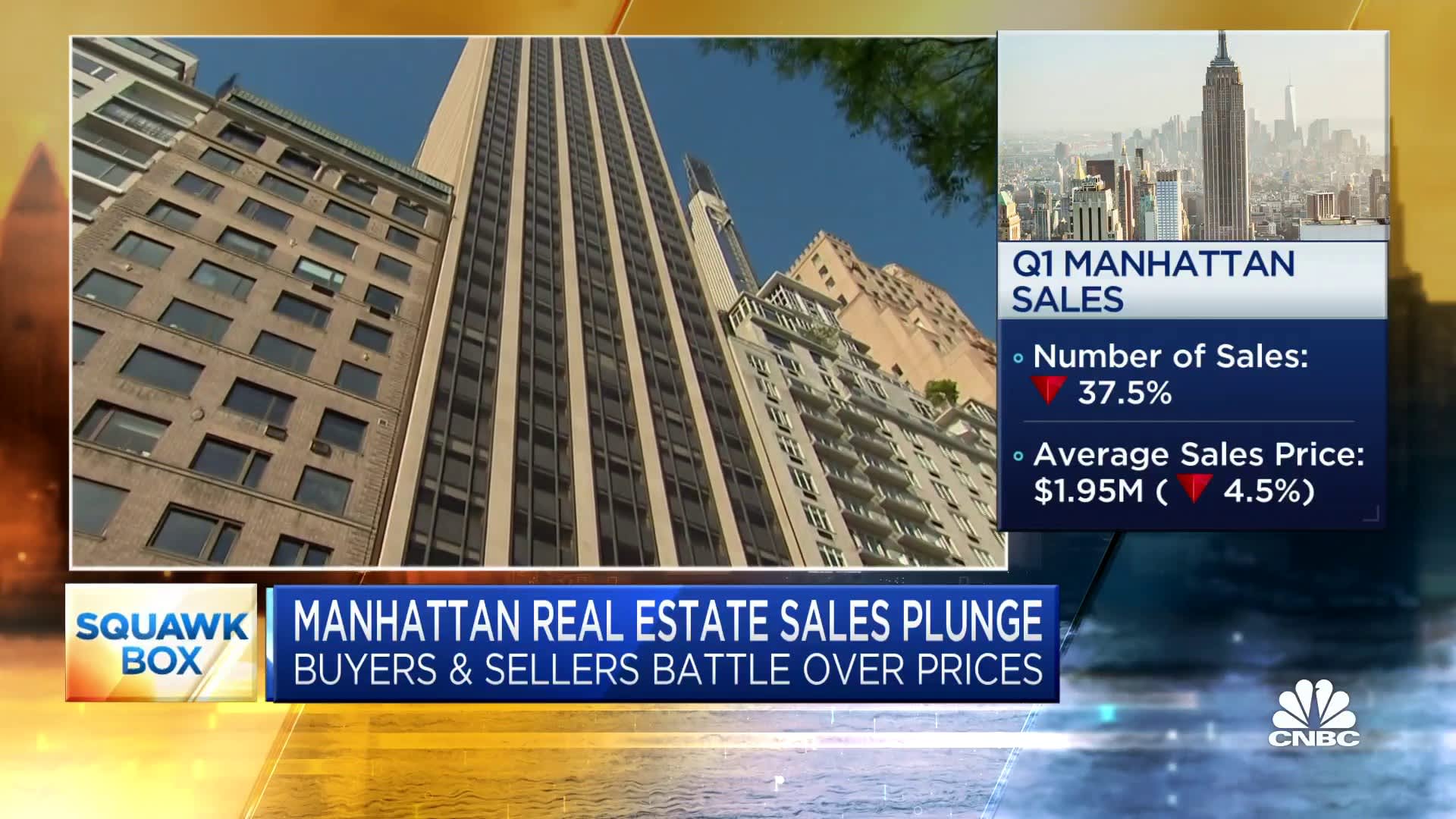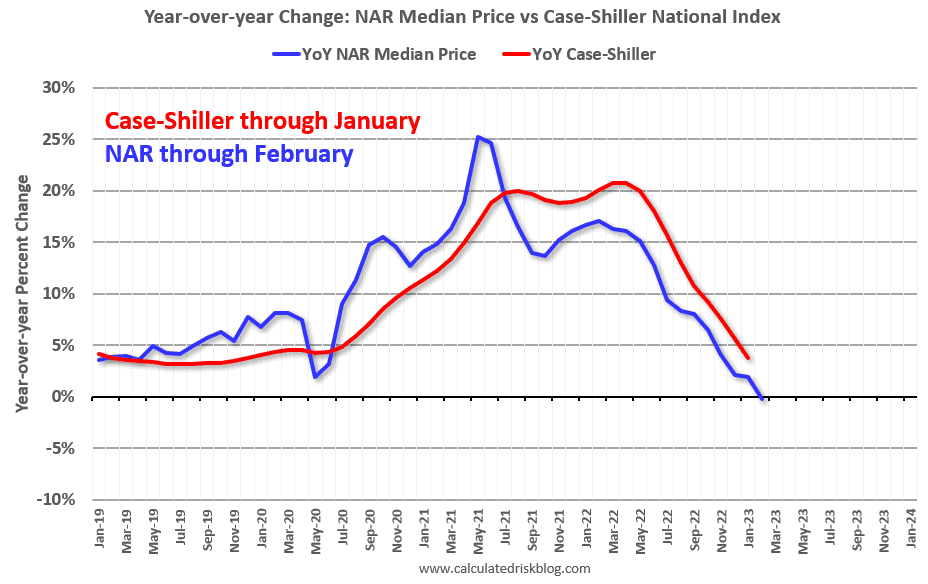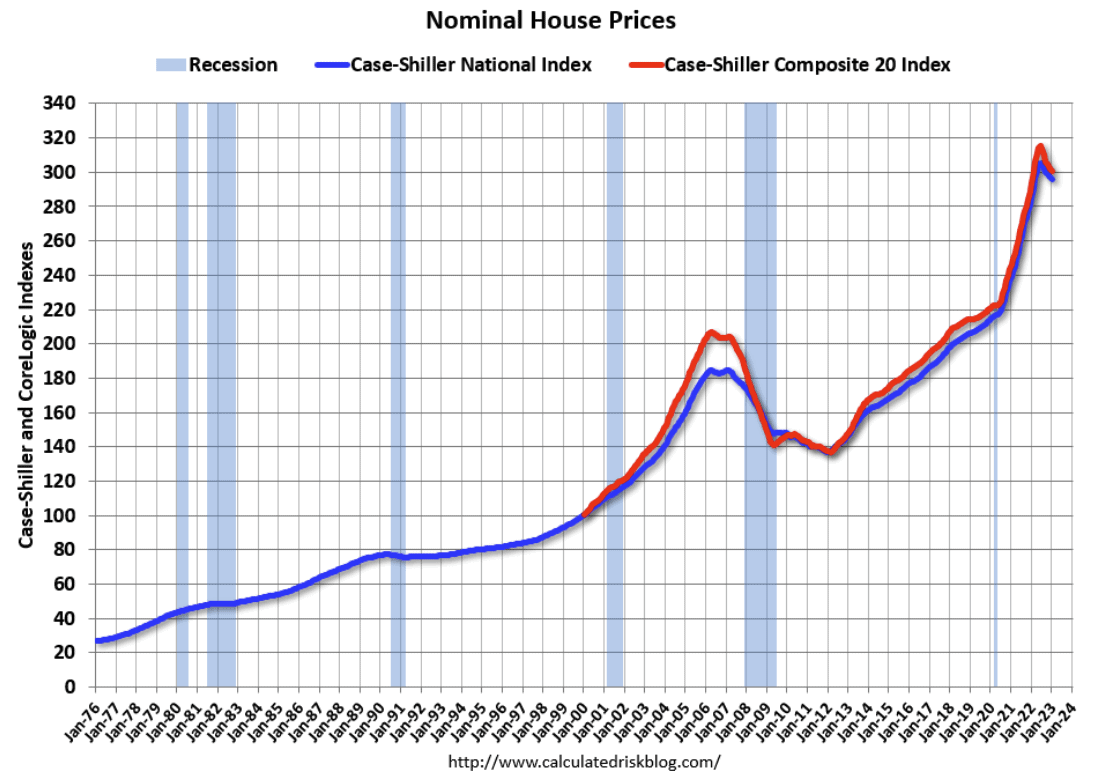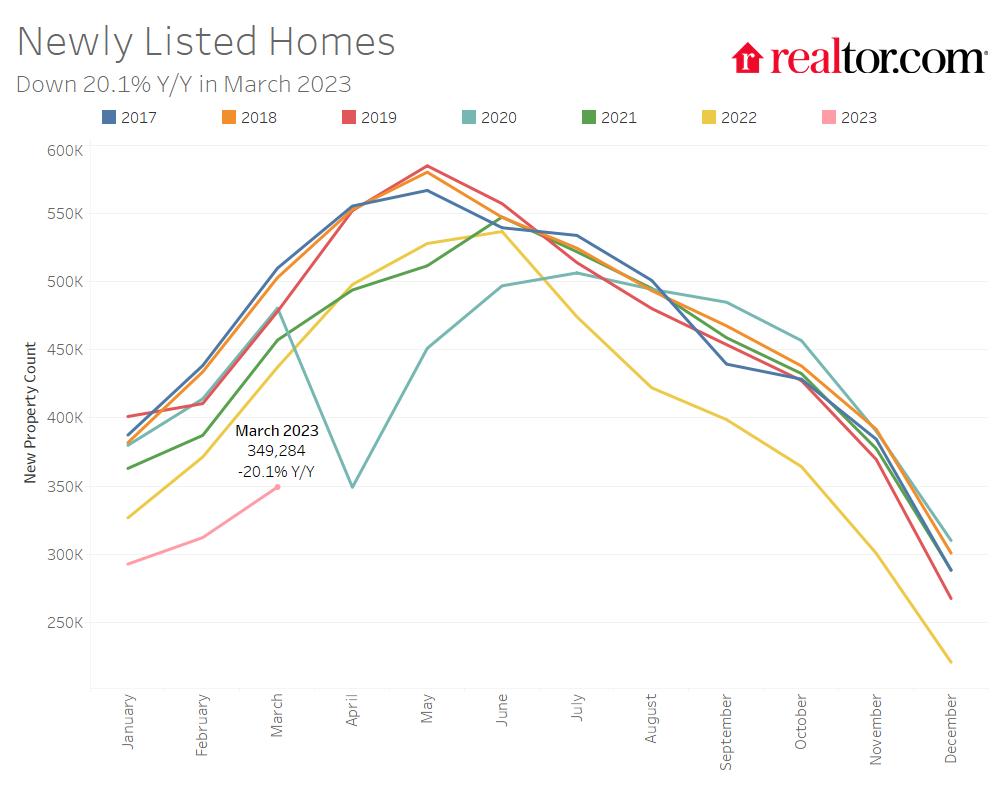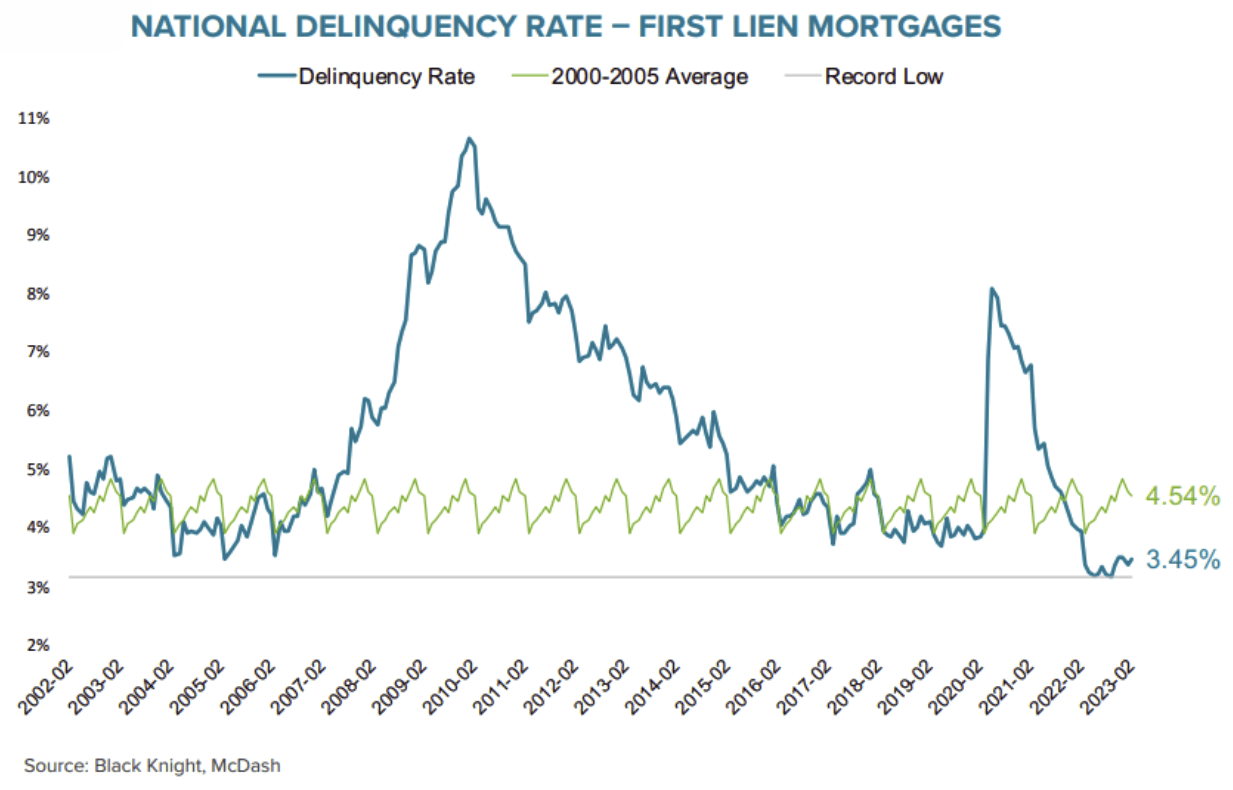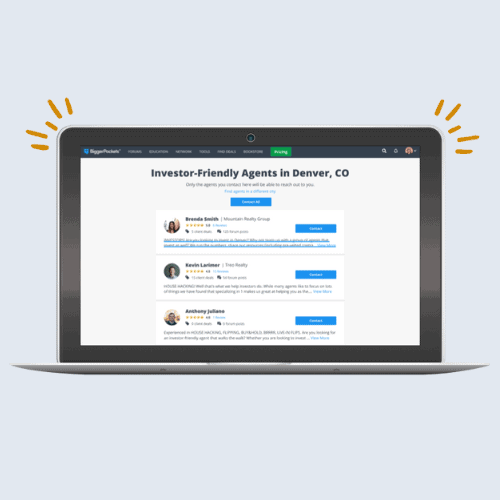David:
This is the BiggerPockets podcast, show 749.
Rob:
I never thought that while I was DoorDashing in college, not having the most clear vision of what I wanted to do after, that real estate would allow me to own over 10 properties right around a million and a half in valuation and have the ability to create some long-term consistent cash flow.
David:
What’s going on, everyone? This is David Greene, your host of the BiggerPockets podcast. Here today with my co-host, Rob Abasolo, with a show that is going to blow your mind. Today’s guest is 22-year-old Josh Janus, who has already established a real estate portfolio over 10 properties, is also selling houses as an agent. He sold $17 million last year. In this episode, Rob and I get into how he’s doing it and what he’s figured out that other people haven’t. My mind is still blown, Rob. How are you feeling?
Rob:
It’s one of those things where I’m just like when you find someone that unlocks something in real estate and they’re absolutely crushing, it’s super impressive, but when you find someone that’s 22 years old making six figures a month doing really well in real estate, it really is just one of those things where I’m like, “Man, I got to catch up.” And I’m like 10 years after this guy.
David:
That leads us to today’s quick tip: Get started in real estate early. How can you get started now? I’ve often heard it said that the best time to buy real estate is 10 years ago. The quicker you get that clock started, the better it’s going to be for you. The best deals that I have is the stuff that I bought the longest time ago. That does not mean to buy bad deals early, but buy good deals early and wait. Rob, what’s something about today’s show that you think people should keep an eye out for?
Rob:
Even with Josh’s success and how much money he was making, which we’ll get into that in the episode, he was still really honest about his fears getting into his first property that he probably could have straight-up paid cash for in one or two months. And so, it was just nice to hear that even someone that could be making so much money could still be vulnerable and fearful in their first deal, but it was really cool to see the glow up and to see that that first deal catapulted him to where he is today. Yeah, just a really cool inspiring moment, I think, to just hear him put it all out there.
David:
He also shares how he got started in business making duct tape wallets and DoorDashing. This is a person who listened to the podcast driving around, dropping off Jack in the box and pizzas and turned it into a real estate empire, just like many of you that are listening to this now really want. This is one I will listen to twice and pull as many pieces of information as you can out of this story to think of how you can apply it to your life. Without any further ado, let’s bring in real estate phenom, Josh Janus.
Today’s guest, Josh Janus, knew in high school that he wanted to retire by 30 years of age, so he built and managed different side hustles, from duct tape wallets to a successful sneaker business. Josh was a college student who also drove for DoorDash. Last year at age 22, he sold over 125 properties in his first year as a real estate agent, totaling over 17 million. As an investor-friendly agent, he has purchased and renovated over 10 properties using very little of his own money in real estate over the last seven months. We are going to unpack this today. Josh, welcome to the podcast.
Josh:
Thank you.
David:
Yeah, it sounds like you have a strong entrepreneurial focus. Before we get into how you accomplished everything that I’ve said, what was it about real estate that attracted you in the first place?
Josh:
When I was younger, I was always trying to save money. I didn’t really know exactly the most productive thing to do with it, but I was like, “Hey, I might as well stash it away and eventually I’ll figure it out.” I had around $10,000 saved up, like free capital to use. I was starting my college career, and I was introduced to the idea of house hacking when basically Googling what to do with 10 to $20,000 when you’re 20. That led me to BiggerPockets and that was my introduction to real estate as a whole.
David:
Did you ever actually go anywhere with house hacking?
Josh:
I was close. So back when I was living in Cleveland, Ohio, I was looking at properties. I figured out where I wanted a house hack, but I ended up switching and going to a different college, I went to the Ohio State University, and then my next journey was going to be the house hack there, but I didn’t actually end up doing it.
Rob:
So Josh, it seems like obviously you’re a little bit entrepreneurial here. Before we get into the real estate stuff, because I think even at the age of 22, having $10,000 in your bank account is a hard thing. A lot of people are like, “How can I get 10,000 bucks?” So can you tell us a little bit about how you even got the 10,000 bucks? Did you just have a ton of side hustles or were you working a job?
Josh:
Sure. I was working. I was doing a lot of side hustles. I used to make duct tape wallets when I was in middle school and try to sell those. That was fun. The next thing was really interested in was sneakers, the whole sneaker culture, reselling, because I was a pretty big basketball player and I was exposed to that industry. I was going to different sneaker events, I would rent out a table, bring as much shoes as I could fit in my couple bags and try to sell them and basically just kept those profits over the years.
Rob:
Nice. What did a duct tape wallet run you back in the day?
David:
Oh, man, it was like $5 to sell. I mean, it was a lot of work for $5.
Rob:
Oh, I see, because I was going to say a roll of… well, toilet paper… sorry, duct tape going to cost you like three, four bucks, so yeah, if you can make-
David:
See, Josh, this is my problem, Rob always forgets to include the value of time. He only looks at the money when he calculates ROI, you can see.
Rob:
That’s true, but you had a lot of time.
Josh:
True. Yeah, I was doing it in class and on the bus.
David:
This reminds me of me. I wish I had had something. I’ve always had a very difficult time paying attention in class, in school. Anytime that I have to follow somebody else’s pace, if they’re talking too slow, I’m like, “Ah.” My brain just wanders. I can’t sit there. They didn’t have fidget spinners. Or what’s the other things that everybody plays with now, Rob?
Rob:
Fidget cubes.
David:
Fidget cubes, there you go. Right? What did we have in my day? We had stupid pencils with different colored lead that you could click the different colors and play with, or we had these bracelets that you could snap on your wrists and they would curl up in a ball. I doubt either of you guys ever saw those things, but-
Rob:
Oh yeah, you still have that bright pink one that you always play with during the podcast?
David:
Yeah. And when I work out. That’s my lucky workout wristband. Bright pink, absolutely. PinkerPockets for the win. You’re entrepreneurial at heart, Josh, which I love because I know this is where you learn the fundamentals that later translated into real estate investing. We interviewed Ryan Pineda on our podcast years ago, and he talked about how he flipped couches. He would buy couches, fix them up, and flip them, which he then later turned into a house flipping business, and now he’s built an entire empire, which I like to think we are basically the ones that launched in into the atmosphere. But Ryan took that atmospheric launch and built something pretty cool out of it. So I’m curious if you could share what lessons do you think you learned with some of these early endeavors that translated into real estate later?
Josh:
I guess in the sneaker culture you would see some of these really cool shoes that athletes were wearing or celebrities, and maybe you’d flip a few pairs, you’d make like 500 bucks. And you’d want to take that profit and immediately buy your own pair to keep and wear. My mindset was I’d rather save that money and maybe put it towards an asset. I learned the idea of assets when I was younger, where you can actually use money to make more money. I didn’t really understand which assets to use at the time. I just knew that concept, and I was like, “It’s got to be a better way of spending my $500 profit.” So I think that’s one thing that I learned for sure when I was younger.
Rob:
By the way, that’s not the worst mindset to have where you say, “I really want this thing, so I’m going to figure out how to make money with this thing that I want, sell it, make a profit, and then get the thing that I want.” That’s real estate in a nutshell, right? You want to acquire property, so you buy a property, you flip it, you take the profits, and what do you do? And usually, if you’re a good real estate investor, you go and you dump it back into another property or you buy a property and have other people pay for it, long-term rentals or short-term rentals. I think the mindset is not incorrect, it’s just really impressive that you found out at a very young age that instead of buying sneakers, you should put it into something that’s going to make you more money.
Josh:
Yeah, I think I was always trying to find more ways to be more productive with my money. I learned early on, for certain, shoes that I have to go to the store and wait multiple hours, I was thinking, “This isn’t very scalable if I want to try to get 20 pairs of shoes because I can’t be simultaneously at 20 places at the same time. I have to learn how to rely on other people.” Different things like that helped.
David:
I tried different endeavors too. I worked at restaurants, and I learned how to sell wine and steak, and then I tried to get a job selling cars at one point and that didn’t work out. But ultimately, I think a lot of us see real estate as the pinnacle we’re trying to get to. We want to sell the most expensive thing we can. Getting a real estate license is not something you need this four-year degree. I wish it was. I’d feel much better if agents had to go get a two or four-year degree to so houses because there’d be less crappy ones out there, and we’ll get into your career there too, Josh. But was it the same thing for you that real estate was just a natural progression of the best thing that you could sell?
Josh:
Yeah, I think so. It seemed like I had to put almost, now they look back on it, the amount of time it takes for me to sell one house was almost the same amount of time and energy it took for me to sell one or two pairs of shoes in some ways.
David:
And your hands aren’t sore from creating these duct tape wallets all the time. It’s easier.
Josh:
Yes, that too.
David:
You let DocuSign do all the work, less paper cuts. All right, so let’s go back in time. You’re in college… I say go back in time, you’re 22 years old, you might still be in college. Where does this interest in real estate start to come into play? How and where did you start to dig in?
Josh:
I mean, I just was googling, “What do I do with 10,000 or $20,000? How do I invest it?” I can’t remember if it was BiggerPockets right away, but I saw house hack, and I was like, “Maybe I could buy a property on the college campus I was going to. Live in one unit, rent everything else out.” That slowly led me to understand, “Oh man, if I become an agent, I could figure out a way to find potentially the best deals,” so that was my goal.
David:
So you didn’t buy a house to house hack, but you got exposed to real estate, it made sense to you, and you thought, “You know what? I’ll just get my license and I’ll help other people do the same thing.”?
Josh:
Yep.
David:
All right. So did you just look up how to get a real estate license and just start studying and do that, or did you have a mentor that guided you?
Josh:
The first thing was diving into the BiggerPockets forums, really. This podcast might sound like a BiggerPockets promotion, but in all reality, a ton of my growth really stemmed from that foundation. But that was one of the first things. And then I also got latched onto a guy named Remington Lyman, who’s also an agent. He works at Reafco Real Estate, he owns the brokerage I work at. But I messaged him, I was explaining my situation. He hopped on a Zoom call with me, explained the benefits of house hacking like, “Maybe if you wanted to become an agent here or come here, we can teach you how to find off-market deals. We can help you build those systems.” And then next thing you know, I was working as hard as I can to get my license.
Rob:
So you’re getting your license, and obviously as you establish your real estate agent business, that’s going to take some time to get that deal flow and actually closing properties and making money. Were you working any other jobs while you were doing this or were you all in at the very beginning?
Josh:
In the very beginning, I was still taking classes. I was studying computer science, and then I was driving for DoorDash 20 to 30 hours a week. And then at any moment I could, I was trying to just cold call. That was my main source of finding deals in the beginning. My plan was cold call, find a deal, or at least get somebody to talk to me about their property, get some details, bring it to one of the agents that I was working with. They would break down the deal, explain like, “Maybe an investor would like this,” or get some clarification on what the rents are, the lease terms are. It started there.
Rob:
Were you ever deep in conversation, you’re like, “Give me one second,” and then you’d pause to take a photo of the DoorDash delivery to upload in the app and then get back on the call?
Josh:
Maybe. I was trying not to do the delivery while calling to… I was doing it when I was driving, but not necessarily-
Rob:
Oh, mid delivery.
Josh:
Yeah. Yeah.
Rob:
What kind of money does a DoorDasher make? If you’re working 20 to 30 hours a week, is that pretty good income? Can you give us a little frame of reference there?
Josh:
Yeah, I mean, I was around five to $800 per week, I think, working that amount of hours. That’s pretty good.
Rob:
Yeah, that’s solid, especially if you’re in college and you’re doing all that. So you’re DoorDash and making pretty good money for where you are in life and you’re cold calling. What was that first deal like when you actually landed a lead that became a transaction that paid you out?
Josh:
Definitely. So I was cold calling four units in what I would call A-Class area. I just found a guy that happened to be motivated that day. He was pretty easy to talk with. I presented it to the agent I was working with, he’s like, “Oh yeah, we could sell this deal.” So I wrote up an email, which is the way that we market our deals, then he presented it to his investors. Somebody ended up taking the deal on. That took about a month to close, as most properties do, and I basically made what I would make in a month and a half from DoorDash from that. I was pretty psyched because I thought, “I just need to knock out a few more of these and I could end up making this produce more income than just DoorDash.”
Rob:
So you started math out like, “Oh man, if I did this three times, I’ll make this amount of money.”
Josh:
Oh yeah, definitely. And then another thing is, if you get your license, you end up making a much bigger cut because you can actually represent either the seller or the buyer, depends on the situation, so I was making a referral fee. So as soon as that deal will close, I was like, “All right, I got to get my license. Let’s start studying right now and try to knock it out.”
Rob:
Yeah. So was that more, I don’t know, a wholesale deal where you’re calling, you find someone, you get a property off-market. They’re like, “Yeah, I’m willing to sell it.” Are you then passing that off to realtors to sell or were you selling it to an investor and taking a small fee for that?
Josh:
I worked under a realtor named Abe, so basically I just wrote all the details of the property, gave to him, and then he found an investor that was interested in the brokerage that I was working at. It’s like a hybrid form of wholesaling. We just don’t actually put the deals under contract, we just present the information to the potential investors.
Rob:
Makes sense. I guess you close this deal, you’re like, “Oh my gosh, I just got to do this many times.” You start getting more into this. How were you able to balance everything from getting your license to finishing college to, I assume, still maybe working some DoorDash here and there?
Josh:
I mean, at that point, basically I was like, “I’m just going to use all of my time outside of school to dedicate towards still maintaining a cold calling schedule,” which I think is really important, “and then getting my license.” So I got my license in about two months.
Rob:
Are cold call hours always 9:00 to 17:00 or were you getting creative and calling from 5:00 PM to 9:00 PM too?
Josh:
9:00 to 11:00 was my cold, cold calls, the people I’d never really talked to. And then I would use 13:00 to 17:000 as a lot of follow-ups or new cold calls. But it seemed like if you hit somebody in the morning when they’re driving, “Oh yeah, yeah, yeah, call me back later,” then I just hit them later, and usually that ended up being a pretty decent converter.
Rob:
David, do you consider yourself much of a very good cold caller? I’ve never heard this side of you before, so I’m curious.
David:
I did it in the beginning of my career when I had to. I didn’t love it, so I didn’t do it a lot. When you’re trying to find deals, most people fall into one of two categories. There’s the direct contact person, which is a cold caller, or there’s the content creator, which gets people coming to them. Most people usually take one of those two paths. And because I ended up as a podcast host and an author, I went the content creation side as opposed to the direct cold call.
Josh, I mean, you did what you could do because you didn’t have a huge podcast behind you to spread the word. I’m curious because you mentioned something, you talked about this wholesale hybrid model. Can you give us a little more detail of what you mean by how you were making money on these deals?
Josh:
So the seller was like, “Hey, I want 450 for this four unit.” And generally wholesalers would write up a contract, get it under contract, and then sell that contract for a fee. The way that we do it at the brokerage I work at, at Reafco, we don’t put it under contract. We just take all the details of the deal, write it in an email, and then present that to our investors. And then if one of our investors likes it or they want to write an offer, we just write up the offer and present it directly to the seller.
David:
How are you being compensated? Are you getting a listing agreement from the seller when you bring the buyer to them and there’s a commission in there for you guys?
Josh:
We don’t actually use listing agreements, no. During that timeframe when I didn’t have my license, I was getting a fourth of the commission for the agent I was working under. He got 3%, then the agent that brought the buyer got 3%, and then I ended up with 25% of the 3%. That’s how we did it.
David:
How were you guys getting commissions if there was no listing agreement?
Josh:
It’s still an executable contract with commissions in the agreement, so it’s going to say, “Seller to pay 6% to our brokerage.”
David:
I gotcha. So you would bring a buyer and in the offer it would have who was getting paid as far as the agents are concerned?
Josh:
Correct.
David:
I see. So rather than putting, getting a house, putting it on the market, letting everybody see it, trying to get offers, negotiating the highest one, you guys just cut to the chase and you said, “Hey, I got a buyer that will pay this much for your house. If you want to take the deal, here’s how much it’s going to cost you. Here’s what the net to use is going to be,” and you guys were running a little more efficiently.
Josh:
Yeah. I think it allows us to take advantage of those leads that aren’t as motivated to sign a listing agreement, because there’s a lot of people that fall in that category, I think.
David:
This is also a form of off-market deal, so other buyers didn’t have access to the same stuff that you guys were bringing them, correct?
Josh:
Yep.
Rob:
Yeah, but Josh, let’s say you’re presenting this property, because you don’t have a contractor, you don’t have a listing agreement, what would stop an investor if you say, “Hey, investor, I’ve got this cool property, here’s the address,” what would stop them from just going over you and going straight to the seller and just transacting the deal themselves?
Josh:
That’s a good question. We have an off-market agreement that we present to everybody prior to setting deals that roughly states, “If you go after a deal that we bring, you have to use us as your agent.” In the beginning when they haven’t signed it yet, we’ll send people rough descriptions of all the deals. It won’t have the address, usually won’t have pictures. But then if they’re like, “Hey, I really like the concept of this deal,” we’ll set on the agreement and then they sign it and we’re good to go.
David:
So it’s a form of a buyer representation agreement. People don’t realize you don’t have to set it up for every house that I show you or every house you could buy. You can say, “For this address, I have to be your agent,” but they could use a different buyer’s agent for different properties that get brought to them. That actually makes sense. I see now why you’re calling it a wholesale hybrid, because wholesalers do it that way. They say, “Here’s a three, two with 1,800 square feet in this zip code that would rent for this much money.” That’s all that people get to start with until they want to analyze it later. So you use that marketing approach paired with real estate contracts to protect each party there. What happened next? How did you get to the point that you were making more from these commissions than you were making from your DoorDashing?
Josh:
So that first check came in, that was about a month and a half’s worth of DoorDash. I had a lot of warm leads, people that weren’t ready to sell right away but they were getting close. I was basically like, “I’m going to take the next six weeks, I’m going to go really hard at this.” At that point, I was spending two to three times more hours per week on this than I was before. Then I got my license, then I started putting a whole bunch of deals in contract.
Rob:
When you say you’re putting two or three more hours, do you mean just in the follow-up?
Josh:
Sorry, my bad, two to three times more hours per week than I was before because I was like, “Hey, no more DoorDash for now, we’ll just work on real estate.”
Rob:
Got it. Was all that time on lead generation, was it following up with… because you said you had a large pool of warm leads, so these are people that, they’re interested, they’re not ready to pull the trigger necessarily, but if you keep approaching them, coming back to them, eventually they convert, right?
Josh:
Yeah, eventually. Yeah.
David:
All right. Were there any key learning points during this difficult time? What was going on in the market at this time? Was it still red-hot? Were things slowing down? Where are we in time?
Josh:
This is the beginning of ’22, so it was still hot, definitely. It was cooling off a little bit, but every deal that was decent that hit the market would have multiple offers and the listing agent would be getting hounded. It was definitely tough. At this time, I also tried to make a bigger presence on BiggerPockets, so I was posting a lot. I think I cranked out 1,000 posts in about three months.
Rob:
Wait, hold on. Okay, so that’s 90 days, so you were posting 10 times to 12 times a day on the BiggerPockets forums?
Josh:
Yep. That was my schedule. I believe from 5:30 to 6:30 every morning I had to spend an hour in BiggerPockets by posting or at least reading content and trying to provide value.
Rob:
Where you were making posts and actually putting content out there, what’s an example of something you’d throw out into the BiggerPockets universe?
Josh:
I mean, most of it was just comments on people’s questions. I would try to answer them the best that I could. I would talk about the Ohio market, the advantages to investing here. I would talk about my journey and how I’m learning.
Rob:
Did you feel like people start to know who you were? Did you get any relationships from doing that?
Josh:
Oh, yeah. People reaching out to me in BiggerPockets. They’re like, “Hey, I see a little bit about this market or real estate investing in general.” At that point, I was trying to manage those leads, and then I was also reaching out to other people. So I set up a Calendly link. I was like, “Hey, set up a 15-minute call with me. We’ll figure out what you’re looking for and how I can help.”
David:
So when the market was hot and listing agents were getting multiple offers, how are you getting sellers to agree to sell their properties through you to a specific buyer rather than putting it out there for everyone to see?
Josh:
I think the fact that we weren’t using listing agreements, they were a lot calmer. They didn’t feel like you were trying to push them to sell. It was more so I was like, “Hey man, what do you need for this property? What number would you not deny?” If that number made decent sense, we’d spend the time to write it up and market it out .
David:
And they weren’t having to fix their house up. I’m assuming a lot of these were probably sold with tenants already inside.
Josh:
Yeah, tenants inside. We’d get the rents, the lease terms. They would almost always be as is. Yep.
David:
What were you doing to find actual properties? Were you just pulling lists? Was this you’d be driving around and just look and see a multi-unit property you thought an investor would like?
Josh:
I was pulling lists from PropStream for the most part and targeting different areas. I was trying to pull lists of people that hadn’t sold in the last year or two years or that bought it for a really low price compared to what it was potentially worth now, because I felt like those could have been more motivated people.
Rob:
All right, so you’re in this world where you’re figuring out your systems, I see that you’ve developed habits, you had a schedule, you’re now an agent. Give us an idea, how long did it take from when you got your license to the first deal that you closed as an agent? How long did that take?
Josh:
That was December to March, so basically three months. I had my first 11 deals fall out of contract. It was pretty brutal. I felt like everything was falling out for the most unique reasons, but it was a big learning experience for me because I was making mistakes, for sure.
Rob:
Man, the 11 deals, that is brutal. David, is that normal at all? I know you run the David Greene team, the most elite real estate agents out there, is it normal for 11 deals to just fall out from a first-time realtor?
David:
No, but as I’m listening to Josh’s strategy here, that starts to make sense. This is more of a volume based approach. He has sellers that are not motivated. He has buyers that they don’t have a relationship with. Everyone’s a bit of a merchant marine here. It’s just pure numbers. If you can get me a deal that gets me the cash on cash return that I want, I’ll go forward. Or if you can get me this number that was probably higher than what they thought the property was worth. So you’ve got sellers that probably want to sell for more than a buyer would want to pay. You get buyers that are looking for the deal of the century. Every time you have these expectations that are off, it’s easier for a deal to fall apart. I’m assuming, Josh, you just had to make up for that with volume. You were probably just a workhorse that was constantly looking for sellers, looking for buyers, matching them together, moving on to the next thing.
Josh:
Definitely, yes. I haven’t really heard a summary like that before. That’s a very good way of explaining it. I was basically just taking two people that had a low chance of closing and putting him together. When that happens, you get a really low chance of closing.
Rob:
David is the king of this, by the way. He is the king of summarizing something so concisely and succinct. I remember we had… Let’s see, who was it? Chris Voss. Chris Voss came on and he gave a philosophical thing, and then David comes in, he’s like, “So basically, based on this and this, it’s this, right?” And Chris Voss was like, “Yeah, it is that. No one’s ever told me that before.” It was like watching… Who painted the Mona Lisa? The painter of the Mona Lisa paint the Mona Lisa, but in the real estate world. Michelangelo. Shoot, I’m about to look so dumb. Everyone in the comments are going to be like, “No, it wasn’t Michelangelo.”
David:
Well, the key is you have to do that with Chris Voss because you don’t want to end up in a negotiation with him.
Rob:
Oh no, I remember who it was. It was also the Blue Angels guy. He had this whole story about how he made a mistake in the jet, and then he was like, “Can you guess the reason that I made that mistake?” and then David was like, “Well, it was probably because you got too comfortable and blah, blah, blah.” And he was like, “I’ve told that story 1,100 times, and no one has ever said that to me. Yeah, that’s exactly why.” He was stunned. So anyways, I always like to point that out when I see it.
David:
Well, thank you. Quick tip here, if you would like to be able to do the same thing, stop looking for patterns to follow or as far as a strategy, “Give me a blueprint, I just want to go do something,” and start asking questions like, “Well, why did that work?” or “Why did that not work?” and then this stuff jumps out. So just from that information alone, I can tell certain things about Josh. He’s a workhorse. He does not get emotionally attached to any of these deals. When he puts something in contract, he doesn’t spend the money before it closes. He’s just like, “That’s a metric that goes on a spreadsheet. I am now back to going to work.” He focuses on what we call the lead measures, not the lag measure, so what is it I can do right now as opposed to measuring something that already happened?
This is all really good advice for everyone. You see this with real estate agents where they work really hard, they put a deal in contract, they get emotionally excited, they celebrate, they go out drinking with their friends, they start thinking about what they’re going to spend the money on, they’re calculating their commissions. Real estate agents can calculate 3% of anything, which is funny because we don’t all get 3% hardly ever anymore. But they get super attached to the deal, and then when something goes wrong, the appraisal comes in low, the inspection report is bad, the client can’t get the loan, whatever it is, they get really discouraged and then they go drinking again. Which is why most real estate agents all become alcoholics, because they’re drinking when they’re excited and they’re drinking when they’re bummed out and they’re just drinking all the time. I think Josh’s approach is much better because you’re approaching the business of selling homes like a real estate investor would think, where you’re just letting the numbers make the decisions. Am I off with that?
Josh:
You’re right. Yeah, it’s just keep put them in contract, figure out what mistake I made there and what can I change in my systems and my approach to potentially avoid that in the future.
David:
Okay, so let me ask you, what are some of the key mistakes that you can share that you learned when you put these deals together that made the deals fall apart?
Josh:
The first thing would be not vetting the sellers. Sometimes they wouldn’t… I mean, kind of funny, they didn’t even really know what they owned. They would say like, “Oh, these are three bedroom units.” And then you give them a contract, the inspector goes there, and they’re like, “Dude, there’s only two bedrooms.” And it’s like, ugh, you can’t do anything about that. You can’t just build a new bedroom. So that’s one thing.
Another thing is I learned about making sure the tenants are paying and the tenants are paying on time. That’s very important, so getting those estoppel agreements potentially in the beginning because that ended up causing issues at the end before closing multiple times. And then not necessarily vetting buyers very well. One example that’s kind of funny is I had a guy trying to buy two properties for $600,000. We fell two weeks prior to close because he couldn’t get financing. I learned that he had less than $10,000 in his bank and he was trying to put 25% down. I’m like, “Do we even do the math here?”
David:
It’s so funny, because I could just totally see how this method would attract those problems. This is trying to find a date on Craigslist. You’re like, “It’s a numbers game, baby.” You just got to keep lining them up because you’re going to get these people that are looking for a deal that’s unrealistic. The $8,000 guy, I bet you what he was doing was he brought this deal to other people and he was trying to get their money on this deal that had a high cash on cash return number because he listens to the podcast and he hears Brandon Turner say, “When you have a great deal, you can find the money.” He didn’t tell you that. He’s like, “Yeah, I’ll buy it,” and then he’s running around telling everyone he can, “What’s the raising private capital script I’m supposed to use?” He’s trying to get someone to come in on the deal. He ran out of time and then he has to just back out of it.
And you, Josh, you get to work your way through all of these really incredible scenarios that normally a real estate agent like us we’re like, “Oh, let’s see your proof of funds. Oh, you have $8,000. No, we’re not going to go show you homes.” You didn’t get to do that. Did you put a system together? Do you have a checklist now? Do you have a screening process for both the buyers and the sellers?
Josh:
Definitely, yeah. I try to write procedures for as many things as I can. I’ll hop on a phone call immediately with the people as soon as I meet them, little 15-minute meeting, make sure like, “Hey, are you pre-approved? If not, I have these lenders that I recommend. They’re great in this area. You want to connect with them.” I try to figure out their timeline, when you’re looking to lock down a deal. Another thing I think is really important for working with investors is, what is your criteria? A lot of investors don’t necessarily put that forward and agents can end up wasting time because they don’t really know what the people are looking for.
David:
Yeah, I think that’s a common complaint investors have too. “I told them what I want. The agent didn’t listen to me.” That’s one way to mess it up. The other way is the agent doesn’t even think to ask what do you want. It’s funny, in our world, someone will say they want a deal and we don’t even think to ask them to define what they mean by deal. Some people mean a really high cash on cash return. Some people mean a property in the best area. Some people mean something at significantly less than ARV. Some people mean just any multi-unit property. It can mean so many different things to people about a deal. Without asking what that means, it’s very hard to make sure that what you’re bringing them is going to land. In your experience, what are most of your investor clients looking for in what they call a deal?
Josh:
Around 60% of the people are trying to get into real estate. They have kids. They have a full-time job. They’re not trying to quit everything and just do real estate. So they want properties that are turnkey or close to they’re occupied, they’re producing a good sense of cash flow. They can buy a couple of those a year and be happy with a good portfolio and they’re done. And then the other 40% of people, I would say, are looking to do value add, the BRRRR strategy, creative financing when it comes up, self-management, anything that’s a little bit more involved and requires a lot more of your time, that’s for the other people.
David:
So these are the financial freedom group that you’re basically working with. They’re trying to get enough cash flow so they can quit their job.
Josh:
Yeah. I have a lot of calls where the first two minutes it’s like, “Yeah, I want to retire in five years.” It’s like, “You can do it, it’s just hard.”
David:
Let me show you how to sell some duct tape wallets.
Rob:
So you mentioned something earlier, Josh, a term estoppel. Do you think you can just give us a quick definition of what that is because it seemed like that was something that was popping up in a lot of these deals that fell out?
Josh:
Yeah. It’s basically a summary of what the tenant is paying, what their lease terms are, and showing that they have been paying. I don’t actually use estoppel agreements. That’s just a term that I thought most people knew. But it’s basically I want to see the rent history. Sometimes the seller will just show me bank account to show that the deposits are coming in or an actual summary or an owner’s statement from the property management company, something showing that the cash flow is real, it’s not fake.
Rob:
11 deals fall through, you close your first deal. Tell us a little bit about the actual numbers on that first one. You said that it was, I guess, the same as working a month and a half in the DoorDash world, right?
Josh:
Yeah. So it was a $450,000 four unit. There was 3% paid to the agent that I was working under, so he got $9,000… oh sorry, $12,000, and then I got a quarter of that, so I got around three grand.
Rob:
Nice. How did that feel?
Josh:
That was really cool. That was the biggest check I think I’ve ever gotten. I was a little intimidated, but I was like, “We don’t spend this now. This is our life for the next two months.”
Rob:
Oh yeah, that’s a lot of ramen noodles right there, especially at the beginning when you’re grinding so much. So let’s fast-forward a little bit because I know you’re grinding it out on the agent side. Tell us about your actual first deal, because David mentioned at the beginning of the show that you bought 10 deals, which I think was about $1.5 million in total for the portfolio. So how did you actually get into the investing side of things?
Josh:
Definitely. I started to sell a lot of properties. By month six, I had scaled my business up to $50,000 a month in commission. Actually I had cash reserves. I found these two duplexes listed by the same agent. They had been sitting on the market for a few months. I called him up and he was like, “Yeah, the owner has short-term debt on it, he really needs to sell it. They’re getting ready to call his note.” They were basically willing to sell them at a 30% discount. I ran my numbers and I was like, “This could make for a great BRRRR, both of them. You could be all in right around 70 to 75% ARV. When you pull your money out, it’s still going to produce a pretty solid cash flow.” So I had to really trust my numbers, but I decided to go after one of them.
Rob:
Okay. So wow, that’s a $50,000 a month, that’s what you were making. How old were you when you reached that number?
Josh:
21.
Rob:
21. David, does that make you feel like… I feel so lazy as a 21-year-old when I was back… I was not doing that. I was trying to make… I don’t know, man. That’s crazy. Congratulations. That is so cool.
David:
I was making less than that in a year, and that was still more money than everybody else that I knew.
Rob:
Dude, that’s crazy. So all of that, the $50,000 a month, obviously that’s going to lead into your investment strategy, but that just came from hunkering down on your agent business, growing those systems, developing your processes, and then you grew it into just 50K a month. That’s insane.
Josh:
Yeah. By month eight I actually got it to about 100K. Ever since then, I’m right around 100,000 a month. I’ve been leveraging VAs for a lot of procedures. I try to delegate as many tasks as I can as a realtor. Try not to, I don’t know, spend all day writing contracts, as an example, because that can take 30 minutes on average. A lot of days I’m writing between eight and 10 offers. That would be my entire day.
Rob:
Can I come work for you, please? Can David and I come work for you? Okay, so you have no deals in the first three months and you start to fire on all cylinders. By June of 2022 you decide to get your first investment, which is a BRRRR, it sounds like, or some kind of rehab. How did that go? Was that a whole new set of skills that you had to learn after already being so good at the real estate side, the realty side?
Josh:
Yeah, I mean I had never done any rehabs. I didn’t really know how to price things out very well. One of these contractors that I had been working with for my clients, I was like, “Hey, can you walk this for me? Give me a bid.” He gave me a bid. The numbers made sense. Another thing was I could only get the price where it made sense if the owner was able to sell both of them. So I was able to find another investor to buy the other one at the same time. We lined them both up. I used hard money for mine. They lended up to 90% of the project cost, which is your purchase price plus your rehab, or 70% of the ARV, whichever number is less.
David:
Well, it sounds like we’re already in the deal deep tag, because this is what we’re going to talk about. So let’s go ahead and make this official. At this segment of the show, we dive deep into a particular deal that our guest has done and get the juicy deets. So first question, what kind of property is this, Josh?
Josh:
It’s a duplex, two bedroom units.
David:
Are you sure there are two bedroom units? Do you know what you have? Are you one of those sellers that claims that he’s got more bedrooms than he does?
Josh:
Luckily this time I knew.
David:
All right, we’ll take your word.
Rob:
How’d you find it?
Josh:
It was on the market. It had been on there for a few months. I called the agent and he was like, “The current owner has short-term debt on it. They’re getting ready to call it. He really needs to sell. If you can sell this one and another one, you can get around a 30% discount.” So my job was to try to sell one of them because then my current situation, I was only comfortable with taking down one deal. I didn’t want to start with two $40,000 rehabs.
David:
Okay. How much was this property?
Josh:
It was 85,000. The rehab estimation was right around $30,000 for the one that I took down. The ARV that I had projected based on sales comps was right around 155,000.
Rob:
How’d you negotiate it?
Josh:
I mean, the agent basically told me that, “If you can close quick, if you can not have many contingencies, you can get it at this price.” So then I counted around 10,000 lower and then we met about halfway in the middle and got the deal done.
David:
And how did you end up funding it?
Josh:
I used hard money. I had to put down around 10%, and then I applied my commission because I was representing myself as part of my down payment. So I was only really out of pocket like $10,000.
Rob:
What’d you end up ultimately doing with this property?
Josh:
I renovated it. It took a little bit longer than expected, as probably the vast majority of projects do. I learned a lot. As soon as I was done, I went to the bank, I refinanced it. I got almost all my money back out, and now I run it as a rental.
David:
Okay. So that was the outcome there. Tell me, what lessons did you learn from this deal?
Josh:
I was really scared of debt. I really didn’t have any debt prior to this. I was definitely scared of short-term debt because the hard money is like they’re knocking at your door in six months like, “It’s due.” The property, you either have to pay it off, you have to refinance it, or you have to sell it. So I was definitely intimidated taking on a property that currently wasn’t livable and needed around 30 grand to be livable. Those are the things that I was scared of, but I learned from the investors and mentors around me that you really need to trust your numbers in any instance when evaluating a deal because that’s what you can rely on, especially when you feel uncertain.
Rob:
So Josh, I guess I’m trying to understand because I know you said you used hard money and you were really nervous about, I guess, getting into this property and that you had needed $30,000 of work. But if I’m remembering correctly, were you making $50,000 a month at this point?
Josh:
Yes. Yeah.
Rob:
So what was the real concern here because it seems like you probably could have covered expenses pretty easily?
Josh:
Yeah. I mean, the property was also not in a city that I was living in, so I was mimicking the experience of an out-of-state investor because I bought it sight unseen. I was managing the entire project from remote, so I learned that.
Rob:
How do you feel now though? Looking back, were you like, “Oh, it actually wasn’t that bad,” or do you still have some of those same reservations doing the out-of-state stuff?
Josh:
I mean, after the first one I feel way better. I feel a lot more confident. I can rely on my team. I can rely on the knowledge that I bring to the table by understanding sales comparables and things like that.
David:
I’ve got two questions. One, have you read Long-Distance Real Estate Investing?
Josh:
Yes, I think that was the first book I read.
David:
Okay, good, because that’s the first book I wrote, so we have something in common. Number two, if I were to make a revised version of this book, based on your experience doing this deal out of state, what would you tell me to include in the book?
Josh:
I read it a while ago, so maybe this was in there, but-
David:
Bro, you’re 22 years old, how long ago could be a while?
Josh:
I don’t know, two years, year and a half. I would rely on multiple project managers. That can take the form of an agent just popping in every once in a while. That can be your property manager that is responsible for tenant relations, or that can just be a completely different contractor that comes in with his own third party opinion about how your project’s going.
David:
So you agree that the philosophy of have several people looking over everyone’s work could extend into the actual rehab management? That’s what you’re saying?
Josh:
Yeah.
David:
Okay. Anything else that I should know because I think I will revise this book, The BRRR, but a couple other ones when I get some time. I’m just curious what needs to go in these books to update them?
Josh:
Don’t rely on sales comparables that are old when you’re initially looking at the deal. Because generally, at least in my state, the appraisers are going to look at the most recent sales in the last six months when they’re appraising your property when it’s done. So the one thing that I did at my first deal was I was relying on a deal two doors down that appraised for the price I was going after, but by the time I was done with the rehab, that sales comp was outside the six-month window so they no longer could use it.
Rob:
That’s probably more relevant today, right?
David:
I think so. Yeah. I was just about to say, for the last 10 years, you looked at comps and that was your worst-case scenario. Odds are it was going to be better by the time it was done. The market has turned around. Rates have went from 3% to 7, 8%. Now we’re seeing appraisals come in low very frequently. A house could have sold for 800,000, you list it for 750, the appraisal comes in for 685 or something because rates have gone up so much. So that’s another thing you got to be aware of is prices can go down now that rates have gone up, and that can catch people by surprise. Any other surprises that came up specifically when it came to buying in another state that you just weren’t prepared for?
Josh:
Always estimate a little bit over your initial rehab budget. The first deal I bought, I don’t think the contractor looked up in the attic, but there were live electric wires running on the floor in the attic, which is number one, very dangerous and number two illegal. I had to address that immediately. That bumped my budget around 10%. I think at every project I’ve done since then, there’s always things that pop up. I think a 10% contingency should always be used.
David:
What about picking tenants, what can you tell us about choosing tenants? Looking into tenant history, what are some things you look for?
Josh:
If you’re buying something already tenant occupied, make sure they’re paying, they’re paying on time. You can see the way that they’re living. If you go in there and there’s stuff everywhere and it’s full of the ceiling, you might not always get your rent on time, let alone even get it. You could still make deals work even with a non-paying tenant, depending on how good it is. Just make sure you’re accounting those expenses in your numbers.
David:
Yeah. We briefly mentioned this earlier, and it’s worth repeating, it’s very easy, especially if you’re a new investor, you haven’t done this for a while, to get a lease to see this property’s making $950 a month, to run your numbers based on the lease. You close on the property, you realize the tenant’s eight months behind in rent, hasn’t been paying. The landlord hasn’t wanted to pay for an eviction or can’t afford an eviction, and so they just sold it to you. That’s why we verify that the money’s actually being deposited in the bank, not just what the lease is for. This is really, really, really important when you’re buying off-market properties or deals directly from sellers like you’re saying, because most people, when their property is doing well, they don’t think, “I should sell it.” Unless there’s like serious concerns in the market and people are thinking, “I want to sell before things turn around,” if your property is making money and nothing’s going wrong, you just don’t think about selling it. But when things start breaking, tenants stop paying, it becomes a headache, you try to fix it. When you realize you can’t fix it quickly, you sell, which is often exactly when buyers are getting introduced to that deal.
If you go in as the buyer expecting this is just a regular house on the MLS that a seller is put in pristine shape and they’re trying to get top dollar, you can really get taken advantage of. Do you have any stories you can share of clients you’ve had or situations you’ve had where that’s been the case?
Josh:
Yeah, an off-market deal that I didn’t sell, but it was in my office, but this is a great example. It was a duplex where both tenants were paying $1,100 a month. The rental comps were truly around 900, max 1,000. So it was really high, which should always be a red flag if you’re seeing units renting for way more than what everything else is around it. But when that property closed, when the seller got his key or when the seller’s PM got their keys and they went to the property, both units were vacated. It was vacant, and they both left. That investor, I’m assuming, was running numbers based on 2,200 a month in rent, and they’re not going to be getting that.
David:
That’s a great example. Thank you for sharing that. Let’s get some quick clarity here. This was your first deal. How quickly did the rest of your deals come together after this first one?
Josh:
Yeah, so the next four that I bought were around a month to two months after that. And then ever since then I’ve been picking up about one to three every single month.
David:
Are these you’re finding them the same way that you were finding deals for clients?
Josh:
Yeah, pretty much the same ways, yep.
David:
All right, Josh, looking ahead, what does your plan look like for how you intend to scale your portfolio?
Josh:
I’d like to build more contracting teams so that I can take on more projects at a time. Right now I’m working on 15 units. I’d like to build a 10X to that, rely on more people, W-2 more positions so that I can rely on them more and cut your cost down a little bit. Those are some lessons that I’ve learned from professional property managers.
David:
Now, are you using the BRRRR method on these properties very often?
Josh:
Yes, for sure.
David:
Okay, so with the change in the seasoning period that we’re seeing with a lot of conventional lenders, have you considered how that’s going to affect how quickly you can get capital out and the speed you’ll be able to scale?
Josh:
Definitely. My strategy hasn’t really been affected by that because I actually am not lendable still because I don’t have two years of the same income as a 1099 person. So basically I’m just refinancing out in non-QM products.
David:
That is awesome.
Rob:
Hey, David, you mentioned that there’s a change in the seasoning period. What is that change? I know with the BRRRR you have to have the tenant in there for I think six months. Is that what you mean, now it’s longer than six months?
David:
No, it’s not necessarily the tenant has to be in there, but if you are buying a property that has a loan on it and you want to refinance and pull cash out of the property, you now have to wait 12 months instead of six months if you’re going to use a conventional loan. Now, Josh, mentioned he’s using no-QM, which stands for non-qualified mortgage. This would be DSER products that you’re hearing a lot of people talk about. It’s important also to note that that does not mean subprime crap. These are still 30-year fixed rate loans. It’s not a whole lot different. The rate’s going to be a little bit higher because they’re not going to be basing your ability to repay off of the money you make, they’re going to be basing it off of what the property will produce itself, sort of commercial underwriting guidelines. But many loans are making you wait 12 months before you can take cash out of a property, not six. It sounds like from what you got going on, Josh, this isn’t slowing you down because you’re just making money through commissions as an agent, you’re not going to run out of cash, right?
Josh:
I don’t think so, no.
David:
Yep. I love that multi-pillared approach. When you’re not dependent on just one pillar, these changes don’t throw your game off because you’ve got several different approaches here. What are you thinking, Rob, about moving forward, Josh’s strategy?
Rob:
I think it’s good, man. I mean, you’re picking up a lot, right? I think it would be wise to really settle into it. If you’re at this point where you’re at 10, I would start thinking about… I guess I’m just seeing it in your personal situation. You’re young, you’re hungry, you’re making a ton of money, and you’re doing the right thing, you’re buying property. Instead of just pocketing 100K every month, you’re moving it into real estate funds. But I would say now is a moment to maybe take a step back and start considering your scale approach. How can you stop putting so much time into one to three properties every month? And how can you start maybe focusing on bigger plays that can maybe even effectively lower your tax bill because I know that this is something that you’re probably dealing with for the first time, making a ton of money and having to pay a ton of taxes on it, right?
Josh:
Yes. I jumped on the whole tax situation as early as I could. As an agent, I set up my intake commission through an S-corp versus an individual, so that lowers my tax burden substantially. And then I can also leverage cost segregations as well in the properties that I’m keeping to lower my commissions coming in. I’m trying to utilize as many strategies as I can.
David:
Absolutely.
Rob:
Hey, you don’t hear 22-year-olds talk about cost segregation all that often.
David:
Never heard that come out of a 22-year-old’s mouth, actually, it’s the first time.
Rob:
Seriously, dude, I feel like we got to talk about cost segregations more just on the podcast because it is the real estate cheat code that can save you, I mean in your case, hundreds of thousands of dollars in taxes. So that’s cool, man. I’m really glad to see that you’re saying it. It seems like you’re scaling up according to what you can do. So just think about how you can most effectively use your time, because you got the time and the money right now, now you just got to figure out how to use it the most effectively.
Josh:
True.
David:
Your first goal was to replace your DoorDash income. You’ve done that. What’s your next goal?
Josh:
My next goal, I want to have 100 units by the end of the year.
David:
100 units by the end of the year, that’s all.
Rob:
I mean, it seems like you’re thinking about exactly what I’m talking about, right? One to three properties in a year, that’s going to be 10 to 30 properties. So obviously you’re thinking, “How can I get to 100?” Right? I think it’s so cool, man, that you’re on this podcast. It’s a very inspirational story. You went from being a DoorDash driver to owning a $1.5 million portfolio. And it’s also just so crazy to know that next year your portfolio is going to be wildly different than what we’re talking about today.
Josh:
I think so, yeah.
David:
Congratulations, Josh. This is an awesome story. Thank you for sharing where you’re at. Very inspirational. You haven’t let anything stop you, including your age or how much I think you look like Dave Franco. You’re pushing forward in spite of all of this. You could have taken the Hollywood route. Instead, you took the real estate investing route, so welcome to our side. If people want to find out more about you, where’s the best place that they can find you?
Josh:
Two places. You can follow or message me on Instagram, @JoshJanus, just my name, and then same thing on BiggerPockets, Joshua Janus, I’m on there.
David:
All right. Rob, where can people find out more about you?
Rob:
You can find me over on Rob Belt on YouTube and Instagram and in your heart. Well, that joke won’t land because the other podcast comes out after this one, but-
David:
You will see why I laughed if you listen to a future podcast episode. That will make a lot of sense. This was a callback before it was actually said. This is some tenant type stuff that we’re getting into where we’re manipulating time for you guys on a podcast. You’re going to love it.
Rob:
It’s a call forward.
David:
Yes, a call forward even better. There you go. Josh, it totally makes sense you don’t know what we’re talking about, it will in the future, so just hang with us here. Thanks for being a good sport.
You can find me on social media, @DavidGreene24. Don’t ever send money to me because I’m not asking for your money. There’s a lot of fake accounts out there, so hopefully at one point I’ll be able to get the blue check mark. I heard that Meta is changing it so that you just pay like 15 bucks a month and people can stop getting scammed. It’s about time. You can also find me on YouTube, @DavidGreene24, or go to my website, davidgreene24.com and see what I got going on.
Josh, fantastic job. Very, very, very excited to hear what you’re doing, especially because you’re an agent and you move forward. Check out my books. Let me know what you think about the three books I wrote in the Top Producing Agent series for BiggerPockets. I’d be curious what you think as someone who’s 22 and is already crushing it. Rob, do you have any last words before we get out of here?
Rob:
Yeah, Josh, you could check out the books that David just talked about, but really the book that you need to be checking out is David’s upcoming book, Scale, which talks about how as a real estate agent you can scale your business. That will be coming out soon.
David:
All right.
Rob:
Promo code for that, we don’t have one. But anyways, check that out.
David:
We’ve got a call forward and a call back all in the same show. Great job, Rob.
Rob:
And we’re back.
David:
All right, Josh, we’re going to let you get out of here. This is David Greene for Rob ‘The Comedian’ Abusolo signing off.
Help us reach new listeners on iTunes by leaving us a rating and review! It takes just 30 seconds and instructions can be found here. Thanks! We really appreciate it!




